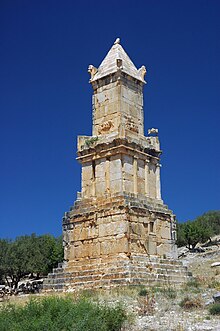
Tifinagh is a script used to write the Berber languages. Tifinagh is descended from the ancient Libyco-Berber alphabet. The traditional Tifinagh, sometimes called Tuareg Tifinagh, is still favored by the Tuareg Berbers of the Sahara desert in southern Algeria, northeastern Mali, northern Niger and northern Burkina Faso for writing the Tuareg Berber language. Neo-Tifinagh is an alphabet developed by Berber Academy to adopt Tuareg Tifinagh for use with Kabyle; it has been since modified for use across North Africa.

Numidia was the ancient kingdom of the Numidians in northwest Africa, initially comprising the territory that now makes up Algeria, but later expanding across what is today known as Tunisia and Libya. The polity was originally divided between the Massylii in the east and the Masaesyli in the west. During the Second Punic War, Masinissa, king of the Massylii, defeated Syphax of the Masaesyli to unify Numidia into the first Berber state in present-day Algeria. The kingdom began as a sovereign state and later alternated between being a Roman province and a Roman client state.
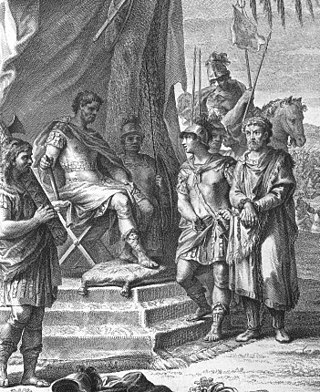
Jugurtha or Jugurthen was a king of Numidia. When the Numidian king Micipsa, who had adopted Jugurtha, died in 118 BC, Jugurtha and his two adoptive brothers, Hiempsal and Adherbal, succeeded him. Jugurtha arranged to have Hiempsal killed and, after a civil war, defeated and killed Adherbal in 112 BC.

Siga was a Berber and Roman port located near what is now Aïn Témouchent, Algeria. Under the Roman Empire, it was part of western Mauretania Caesariensis, bordering Mauretania Tingitana.
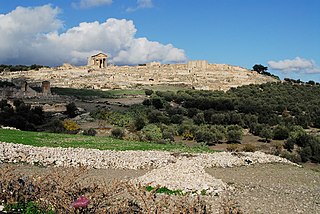
Dougga or Thugga or TBGG was a Berber, Punic and Roman settlement near present-day Téboursouk in northern Tunisia. The current archaeological site covers 65 hectares. UNESCO qualified Dougga as a World Heritage Site in 1997, believing that it represents "the best-preserved Roman small town in North Africa". The site, which lies in the middle of the countryside, has been protected from the encroachment of modern urbanization, in contrast, for example, to Carthage, which has been pillaged and rebuilt on numerous occasions. Dougga's size, its well-preserved monuments and its rich Numidian-Berber, Punic, ancient Roman, and Byzantine history make it exceptional. Amongst the most famous monuments at the site are a Libyco-Punic Mausoleum, the Capitol, the Roman theatre, and the temples of Saturn and of Juno Caelestis.

Maktar or Makthar, also known by other names during antiquity, is a town and archaeological site in Siliana Governorate, Tunisia.

Althiburos was an ancient Berber, Carthaginian, and Roman settlement in what is now the Dahmani Delegation of the Kef Governorate of Tunisia. During the reign of emperor Hadrian, it became a municipality with Italian rights. It was the seat of a Christian bishop from the 4th to 7th centuries. The settlement was destroyed during the Muslim invasions and the area's population center moved to Ebba Ksour on the plain. This left Althiburos's ruins largely intact; they were rediscovered by travelers in the 18th century.
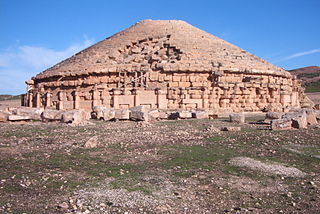
Madghacen, also spelled Medracen or Medghassen or Medrassen or Madghis is a royal mausoleum-temple of the Berber Numidian Kings which stands near Batna city in Aurasius Mons in Numidia, Algeria.
Zeineb Benzina, whose full name is Zeïneb Benzina Ben Abdallah, born in Tunis, Tunisia, is an archeologist, and director of research at the Institut national du patrimoine based in Tunis.
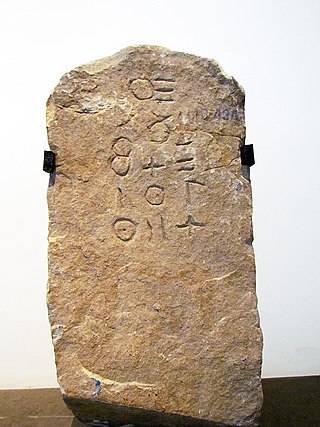
Numidian was a language spoken in ancient Numidia. The script in which it was written, the Libyco-Berber alphabet, has been almost fully deciphered and most characters have known values. Despite this, the language has barely been deciphered and only a few words are known. Libyco-Berber inscriptions are attested from the 3rd century BC to the 3rd century AD. The language is scarcely attested and can be confidently identified only as belonging to the Afroasiatic family, although it was most likely part of the Berber languages, spoken at the start of the breakup of the Proto-Berber language.

The Arch of Alexander Severus is a Roman triumphal arch in the ancient civitas of Thugga, located in Dougga, Béja, Tunisia. It was dedicated to the Roman Emperor Alexander Severus.

The Punic-Libyan bilingual inscriptions are two important ancient bilingual inscriptions dated to the 2nd century BC.

Thucca Terenbenthina, also known as Thugga, was an ancient Roman-Berber town in the province of African Proconsularis. In late antiquity, it was made a municipium of the province of Byzacena. Thucca Terenbenthina is identified with ruins located in the modern town of Dougga, Tunisia.

Henchir-Ed-Douamès is an archaeological site and locality in Tunisia, North Africa.
Naïdé Ferchiou was a Tunisian archaeologist whose work dealt mainly with Roman North Africa. She excavated at several important sites, including Abthugni.

Sir Thomas Reade was a British Army officer during the Napoleonic Wars, known also as a collector.
The Diocese of Thucca Terenbenthina is an ancient Titular See of the Roman Catholic Church. The diocese is also known as Tucca Terebentina or دڨة, .
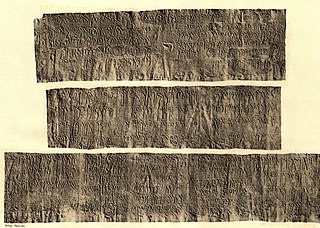
The Maktar and Mididi inscriptions are a number of Punic language inscriptions, found in the 1890s at Maktar and Mididi, Tunisia. A number of the most notable inscriptions have been collected in Kanaanäische und Aramäische Inschriften, and are known as are known as KAI 145-158.

Masinissa, also spelled Massinissa, Massena and Massan, was an ancient Numidian king best known for leading a federation of Massylii Berber tribes during the Second Punic War, ultimately uniting them into a kingdom that became a major regional power in North Africa. Much of what is known about Masinissa comes from the Livy's History of Rome, and to a lesser extent Cicero's Scipio's Dream. As the son of a Numidian chieftain allied to Carthage, he fought against the Romans in the Second Punic War, but later switched sides upon concluding that Rome would prevail. With the support of his erstwhile enemy, he united the eastern and western Numidian tribes and founded the Kingdom of Numidia. As a Roman ally, Masinissa took part in the decisive Battle of Zama in 202 BC that effectively ended the war in Carthage's defeat; he also allowed his wife Sophonisba, a famed Carthaginian noblewoman who had influenced Numidian affairs to Carthage's benefit, to poison herself in lieu of being paraded in a triumph in Rome.

The Libyco-Berber alphabet or the Libyc alphabet is an abjad writing system that was used during the first millennium BC by various Berber peoples of North Africa and the Canary Islands, to write ancient varieties of the Berber language like the Numidian language in ancient North Africa.
